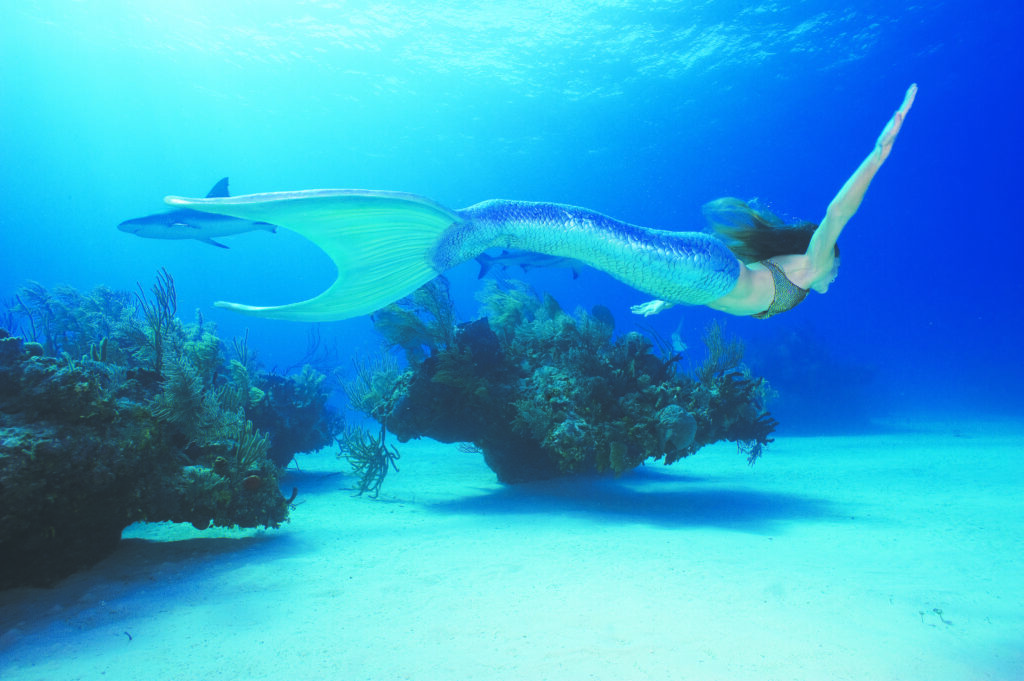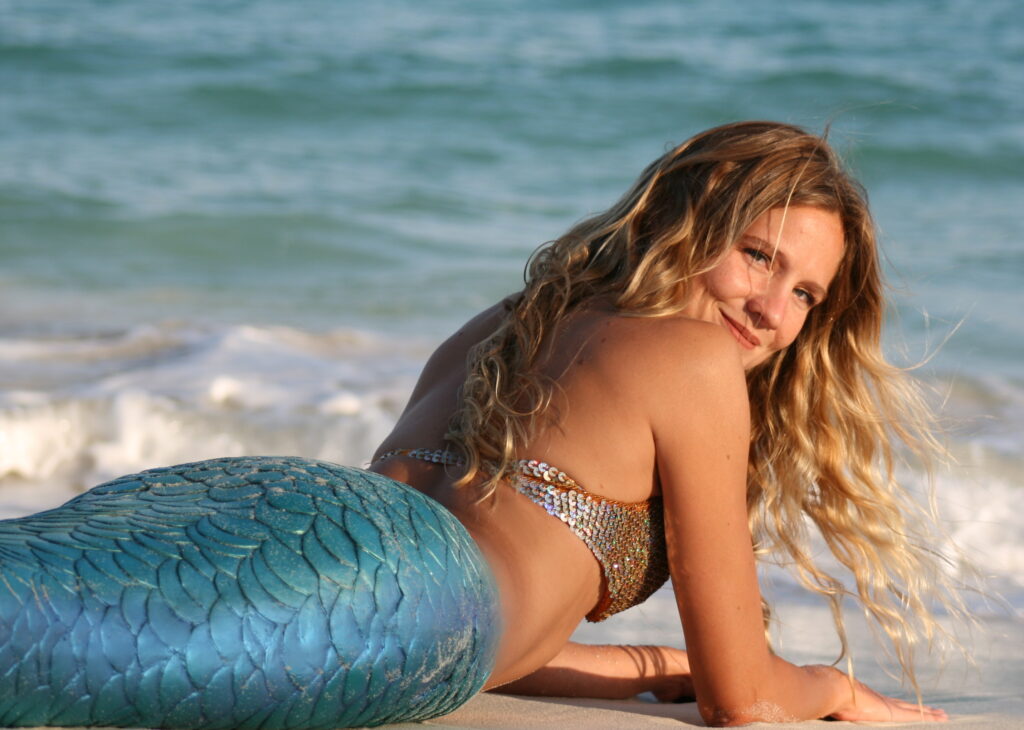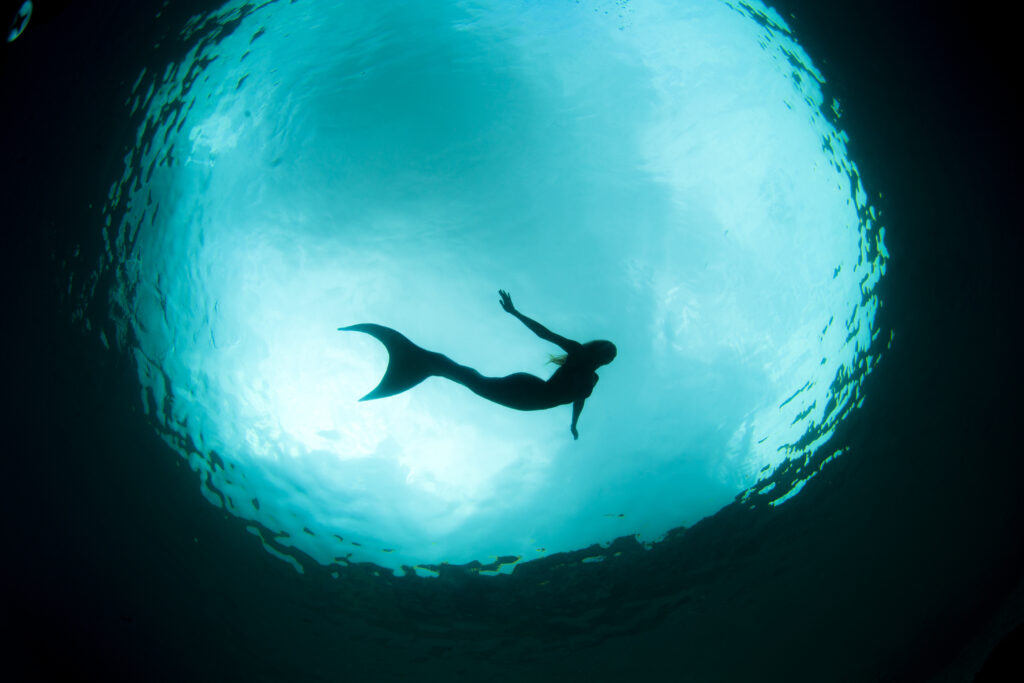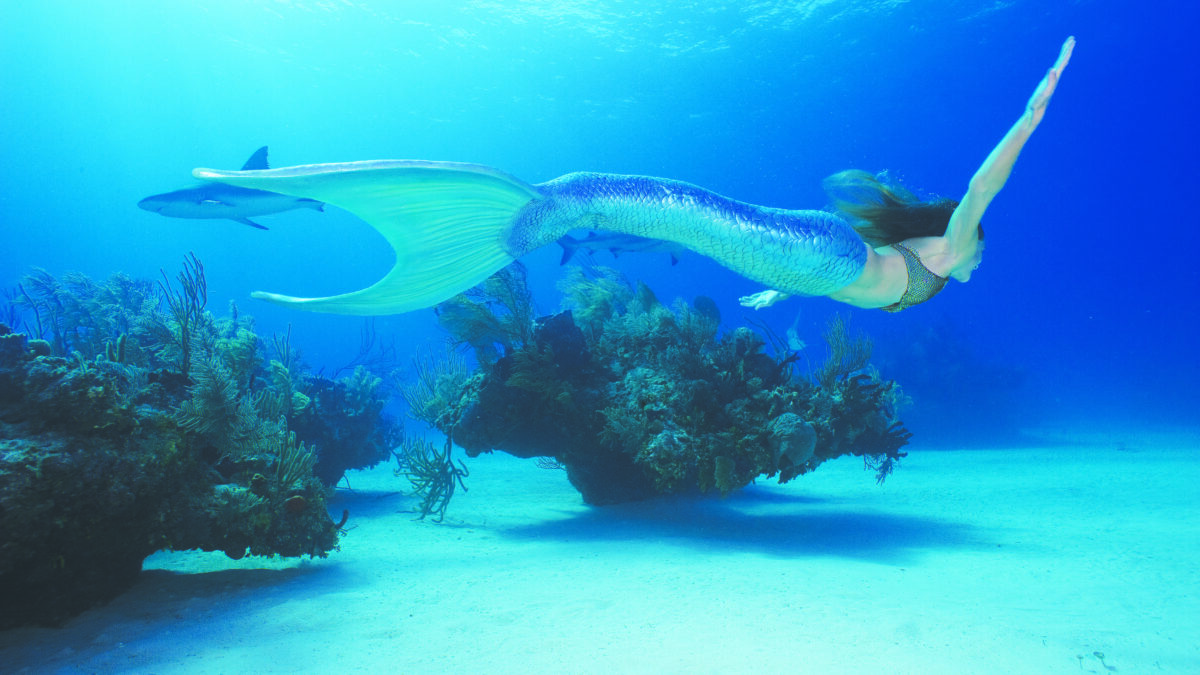
An Interview with Linden Wolbert
Among the oaks and rocky canyons of Topanga lives a real live mermaid.
Linden Wolbert is a professional mermaid or entrepre-mermaid and ocean “edutainer” who uses her freediving skills to perform underwater, transforming herself into a mythological being.
How did you come to be a mermaid?
It starts when I was just a little sea squirt really. When I was little, I loved the ocean. I grew up in Amish country, and I lived far away from it.
I was on swim team growing up. The water was always my favorite element. I loved swimming and the pool was my little respite. It was where I’d go and swim my laps and see how long I could hold my breath and stand under water and play with my friends. Eventually that just blossomed into this idea that I’m comfortable in the water. I love it.
Every time my family would go to the beach, I was just enraptured. I loved playing in the waves, picking up seashells, exploring what critters were in the tide pools and in the rocks. As I grew older, I started watching wildlife documentaries on PBS and BBC. And I just thought, could I make those? Maybe there’s a chance I could make wildlife documentaries. I decided to go to film school, study environmental science as well with this dream of becoming an underwater wildlife documentary cinematographer and filmmaker. I went to Emerson college in Boston. In my final semester of my senior year, I was able to go to Los Angeles and intern. As soon as I saved up sand dollars, I got scuba certified.
When I became a certified PADI (Professional Association of Diving Instructors) scuba diver, I realized this is the environment that I wish to be in. This is the story I want to share and tell. This is the visual aspect of the world that I just find to be the most enchanting. So, I decided it’s time to start making some underwater stories and documentaries. But when I found out about the sport of freediving, it became quickly apparent that there was an even more immersive experience I could have that didn’t involve all of the equipment. So, I brought just everything, all of this energy and transformed it into this idea of becoming a mermaid after I went and filmed a free diving competition. And I saw these freedivers in mono fins, swimming like mer-people. It was so graceful. It was beautiful and I was just intrigued.
I saw the mono fins and I thought, “Uh Oh, I think I need to try that immediately.” One of the competitors had the same shoe size as me and she permitted me to borrow her mono fin after she was doing a world record attempt. It was incredible. I flew through the water. I felt the wind in my hair. I felt the speed, this incredible sense of freedom in the water that I just never experienced before. That was it.
Tell us about this 50-pound tail that you had made.
So, I realized I needed a tail if I planned to be a mermaid. And there was a lot involved in making that a reality. It was not easy. I guess I’m rather persuasive when I’m passionate, but my parents, my family, my friends, some of them giggled. “Hey, I’m going to disappear for awhile. I’m going to be focusing completely on this. And I’m making a mermaid tail. I’m going to be a mermaid.”
So, we “mer-made” a tail. Along with a very dear friend, Allan Holt, who is a special effects artist in Hollywood. I imagined a tail, this appendage that would be resilient, functional, hydrodynamic, which is the underwater version of what airplanes do and create not only the visual of a real mermaid but make me feel like one. An extension of my very being was how we wanted to “mer-make” this tail. And in the end, we created a beautiful, realistic, functional, resilient tail. We still have the fiberglass mold. I still have tale 1.0, it still works. It’s still great. But we did upgrade with tail 2.0 which is here today.
In the words of Dr. Seuss, those who mind don’t matter. And those who matter don’t mind. But I do love what I do. I love making people smile and I am an idealist and an optimist. That I know.
I want to share it with people. And I thought, instead of just doing a normal documentary, that’s a talking head or a narrator, and you have these beautiful images of creatures. What if a mermaid were teaching children about these ocean animals in these habitats and these conservation techniques, or just planting seeds in young minds, little sea sponges.
I call them my little sea fans because they’re just impressionable and they love to learn. Kids love to learn and that’s when my passion started. So, this idea of a younger demographic to receive these messages through beautiful imagery. You know, I’m not much of a doom and gloom person. There are a lot of people who will take a different tactic of conservation methodology and say, “If we don’t stop now, everything’s going to die. We’ll look at what’s happening. This is awful.” And while that works for some people, that method doesn’t work for me. I see something beautiful and I want to preserve it. I see something that’s having trouble, I would like to, how can I enhance it? How can I help it flourish? How can we nurture it? What can we do? So, for me, sharing the beauty of the underwater world is the best way to convey a message of hope, conservation and preservation and exploration too. Gosh, get in the ocean, explore. What better way to fall in love with it than to be in it.
The kids love it. I get little sea fan mail and, I mean, it’s just the sweetest thing to hear children watching. I have a little web series called Mermaid Minute, and that is how I take all of my passions and roll them into one thing. It’s the thing that I can express imagery, storytelling, science, facts, fun, be a mermaid, share the magic and tell the stories and the information in a way that is fun. It makes learning fun. It’s immersive. And there’s music, sound effects. They’re seeing all the layers that you can put into a visual medium. The only thing you can’t do is feel the water and smell the salt.
Working with single digit children is nothing short of pure magic. I once surprised children in a glass bottom boat, that was almost like a submarine. They were getting a tour of their local reef in Roatán, in Honduras. And suddenly this mermaid appears over the reef and I could hear them. The magic of water is that it is so dense that sound travels farther underwater than it does on land. I could hear these children in this submarine-like boat screaming, “Sirena, Sirena!” They were saying “mermaid, mermaid, mermaid” in a chorus. It was as though The Beatles got off an airplane in the United States for the first time and I couldn’t believe how excited these kids were.
And I wasn’t wearing a mask of course, because I was in mermaid form. And again, I found myself crying underwater. Luckily, they couldn’t tell because I was surrounded by water, but I was waving at them and I could see the little outlines of the hands waving in the port holes, in the windows. It’s pure magic, children believe in magic. And the line between fantasy and reality is very blurred until about age seven, eight is where the line begins to become more finite, where they can tell and discern the difference between fantasy and reality. Their energy, the excitement, the wonder in their eyes, working with them is pure joy.

And you’ve helped some of them; you are helping them become mer-people as well.
Yes, merlings. Little sea fans becoming merlings. There are a lot of kids who aren’t well, and wish foundations like Make-A-Wish and others who provide wishes to little boys and little girls who have wished to become a mermaid or a merman for the day.
Swimming with children who have a lot to worry about and don’t often escape from the confines of a hospital or a bed and putting them in a state of neutrality and neutral buoyancy and they’re unencumbered. And then they can swim.
There were so many kids who wanted to be mermaid, or a merman. What’s it like to be a mermaid? How does it feel?
I met the right people and companies and partnered and got to design mono fins. And knowing what it’s like to swim with a fin, I knew the best ways that it would be likely a child could be comfortable and safe. And so now these kids get to put on these mono fins and tails and become merlings.
They get to learn about the ocean at the same time. They get to feel what it’s like to be a mythical creature. They get to experience the magic of the water The first step to making a child an ambassador for the oceans, is to get them excited about the ocean, excited about the creatures in it. And they become one of them. They become an ocean creature. So, then they empathize with the ocean and its inhabitants in a new way. It’s tangible. It’s experiential.

How did you figure out how to do that?
I went down to Grand Cayman and I was filming a freediving competition. And I was around world champion freedivers. Now it’s a very small sport. I’ve never really been an athlete, not terrestrially, not very good on land.
So, I took a course and right off the bat, I did a three-minute static breath hold, and I was able to dive to 25 meters down, which is about 97- 98 feet, I think is the translation, roughly. Everything’s done in meters in freediving. And it just felt so good and I loved it. And so, I’ve never actually competed in the sport. I became a judge myself because I’m fascinated by the psychology and the physiology and how they work in tandem. It’s mostly psychological, the sport of freediving, to calm your heart rate, to slow down your metabolic pressure to breathe.
I can hold my breath for just over five minutes, and find a state of calmness, this inner calmness. And a lot of people are really, kind of, spiritual about freediving. There’s a lot of yoga and breathing techniques that help people achieve the goals that they wish to in competitive freediving.
Freediving is an extreme sport. When you hear the words extreme sport, and most people think of snowboarding or skateboarding or a high velocity sport where freediving is completely the opposite. It’s this very contradictory thing for an extreme sport to be focused on methods of calming and honing into your core, your center, your place of peace, so it is a unique sport. Oftentimes on a platform out at sea for a depth competition, you’ll see the competitors who are about to go up for their dive attempt. They’ll sit and they’ll just be meditating, closed eyes, calm, maybe saying some mantras. Everyone has their own unique way of preparing themselves mentally and physically for a freediving attempt.
Once you reach a point, where for me, for example, I went to a hundred feet, which is the recreational limit of scuba diving as an advanced scuba diver on a tank. Weirdly, that was more scary to me than diving down to a hundred feet on a single breath of air with no other apparatus to help me. Just a mask, a snorkel, a weight belt, and a pair of fins or a tail, depending on if I wished for my tail that day.
Sometimes if you’re really cheeky and you’re in a place where there are people scuba diving and you’re freediving, or even in a tail and you freedive down and you’re around all these bubble blowers as we will call them. And suddenly you swim by not donning any equipment or gear and people are just completely flabbergasted. And it is a funny thing to do and to see their faces when you swim by.
Have you had any really special moments where you’ve had interactions with animals under the water, just connecting with nature?
Oh, I’ve had so many memorable underwater experiences. I mean, on scuba as well. You know, the luxury of scuba diving is you can stay for a while and observe something. Whereas with freediving, there is a limit to how long you can hang out. But when I’ve been freediving, I find the animals are much more welcoming. They’re much more accepting because you feel like you’re one of them, you know, here we are, these mammals and we have a lot of the same capabilities, for example, that a sea lion or a seal has. I mean, think of all these other air breathing mammals who we observe, you know, we have the whales, we have the dolphins, we have the porpoises. And then we have fish and sharks who just have gills and are swimming around.
I think that when you’re in a freediving experience underwater, the animals see you as one of them, much more so. They accept you as another aquatic creature. Whereas if you were wearing a tank, we liken that to a loud motorcycle clan, driving through a quiet Topanga neighborhood on Thursdays, always Thursdays. But yes, it’s an incredible experience to be welcomed by ocean creatures in the form of a breath holding mammal. My most memorable experiences underwater free diving with animals? Gosh, I went down to Mexico and didn’t know I would have an opportunity to swim with whale sharks. It had been a dream to swim or see, just to see a whale shark. You know, these incredibly huge creatures, they’re the largest sharks. They’re basking sharks, which are the next down. But these whale sharks look like a constellation of stars just landed upon their skin.
And if you pair that, when they’re normally around the surface and they’re feeding for plankton, they’re swimming about, they look so effortless, but they fly through the water with great velocity because they’re so huge and powerful in the water column. But to be in the water, swimming next to a whale shark, I felt so dwarfed in size. I felt so overwhelmed. I had never seen something this large in the water right next to me. And it was one of those moments where, you know, at first, I had to wear a mask. I had to see it because mermaids don’t wear masks, right? And when you remove the mask, you remove the clarity in vision. You can see the blurs, you can see the shapes and the outlines, and you can see and feel the sheer size and energy of these Namath creatures.
But to actually see it with a mask at first, of course I flew in the water. We were in shark soup. They were everywhere. There were over 30 whale sharks aggregating in this area off the coast of Mexico. This little Island called Isla Mujeres, the Island of Women. I have this constant dissonance of a freediver. I’m so energetic and excited that to calm my heart rate down so I could actually hold my breath and dive for any length of time and I’m seeing a whale shark for the first time. So excited! I had to just calm down, calm down, calm down now. They’re not going anywhere. You can take your time here. And I jumped in the water and I was in a tail. Of course, I wished for my tail that day, I dived in the water with the whale sharks. And I am quite emotional about things. I definitely cried in my mask when I saw those whale sharks and saw that constellation and there’s that little eye looking at you out of the peripheral vision. It sees you. You know it’s aware. These animals know. They see you, but they’re not bothered, and you respect their space, and they respect yours. And you do your best to keep up with them in that water space because man oh man are they powerful. Just incredible.
There are some predators out there in the sea. How do they react to you?
The very first time I had the honor of mermaiding with sharks was in the Bahamas and it was with Caribbean reef sharks. And they’re kind of like puppy dogs, but they still bite. They still have teeth. They still have predatory tendencies and sharks go by a hierarchy of size with other creatures and within their own community. So, an interesting thing about sharks is if they know you are aware of them, it kind of disarms them. So, for example, when I’m not wearing a mask and I can’t see where their eye is, specifically, I see a shape. I see a dark shape in this clear blue water, but then I think, okay, Linden, where is that shark’s eye? Look at how it’s swimming, try to look in that direction, so it knows you see it. So that was the first thing that I learned to do not having on a scuba or freediving mask. When we tried to get sharks in the shot with me for the first time in my silicone mermaid tail, it was very hard to get them in the shot. They were wary of me because, in the tail, I’m about eight feet long or so. And from top of my head to the tip of the fluke, I outsized some of those sharks and they weren’t sure.
So, I was swimming across actually some beautiful coral, over this beautiful rippling white sand, about 40 feet down. And it was funny because I would swim across and we actually had two safety divers in this instance because they didn’t want me going up and down and up and down because that can actually disturb the sharks more. So, they might think that you’re hopping in and feeding them or something. And they’re like, “Oh”, and they might follow you. So, they said, “Look, we’re going to have two safety divers, and we’re going to have you swim across frame. And each diver will have an extra regulator breathing apparatus for you from a tank so that you can swim back and forth and take a breath and then swim back and forth.” At each station, I had a mask so that I could put the mask on, clear it, look at the director and cinematographer, and they would hand signal what they want me to do, like swim up and then down.
You learn an underwater language with your team and I’m always surrounded by a safety team. That’s crucial. Safety is imperative and paramount. So, I had this experience with these sharks where we couldn’t really get them in the frame at first. And we actually had to let them get used to this creature who they didn’t recognize that was bigger than some of them not blowing any bubbles and was moving kind of like, you know, a mammal might. Not like a fish, not side to side. So, they were a little confused. Is it a large dolphin? Is it a small whale? What is this? But finally, after some time, the sharks became a little more curious and would come around and swim through and swim over me and I would swim toward them. And they’d kind of be like, “Hmm.” So, it was amazing. And many people are afraid of sharks. Many people think that they are just these man-eating machines. When in fact, in my experience in many places around the world, sharks are much more frightened of divers, whether with a tank or without, then we are of them. So, I’m not worried about sharks, most sharks. Okay, maybe bull sharks, maybe tiger sharks, depending on the application.
I have two favorite places to dive because I see two categories of aquatic environment. There’s warm-water and cold-water diving.
My favorite cold-water location to dive is right here off the coast of California. Southern California is rich with kelp forests and giant kelp. It’s like a cathedral. I don’t know if anyone who has watched wildlife documentaries, hasn’t wished to go dive in the kelp. The first time I saw an IMAX film where you were taken under water in a kelp forest, I just lost my little mind. And I thought, well, “That’s on my bucket list.” And I ended up becoming certified to scuba dive in the kelp forest off the coast of Catalina Island. And I did, I just wept at my mask. You couldn’t believe it was real. It wasn’t Jacques Cousteau. I was not watching a television. It was not in a little rectangle. It was actually in front of my face and I just, ah, I was in it.
How would you describe the people of Topanga?
I love the people of Topanga. The people of Topanga are authentic, thank goodness. To live in Los Angeles, where there’s a lot of, we’ll call it in a mermaid way, surface interaction going on. Things get deep here very quickly because people are real. They are authentic. They’re passionate. There are a lot of artists and creatives here. There’s a lot of heart in Topanga Canyon. This place is so unique, and I don’t believe there’s any place else like this, dare I say in the world and I’ve done a lot of traveling. I’ve seen a lot of communities and culture and food and art and heard a lot of music and Topanga is just, it’s very special.
After working as a mythical creature, “edutainer,” visual storyteller, inventor, and serial entrepreneur for the better part of two decades, Linden focuses her passion and business acumen on helping others see life through the brilliant lens of infinite possibility. Linden’s virtual “Smile Sessions” for life and business are now available as a result! Everything is possible…take it from a professional mermaid! Learn more at www.SmileSession.com












